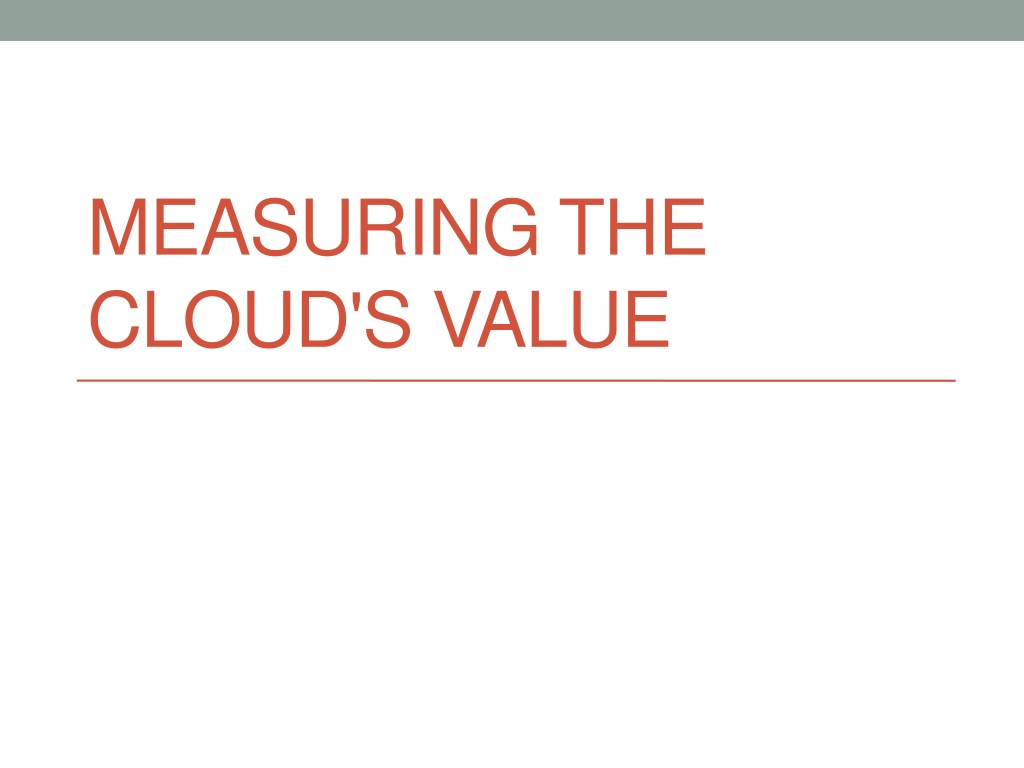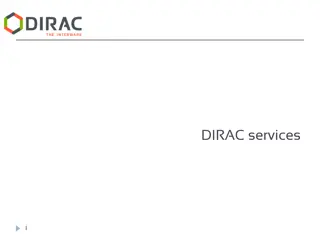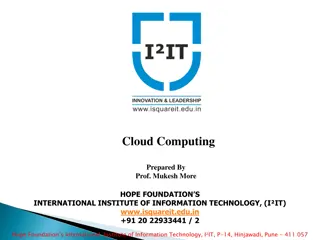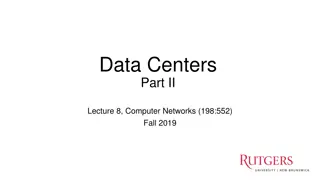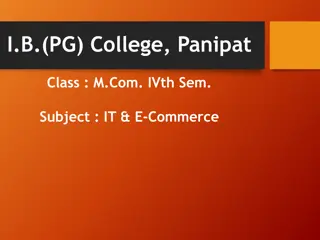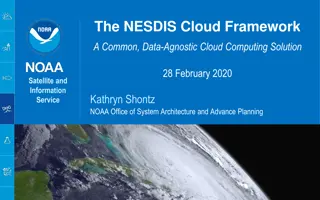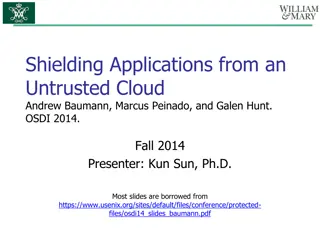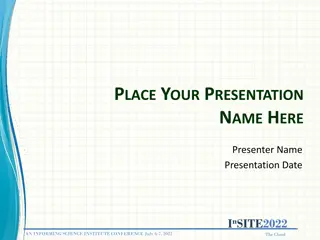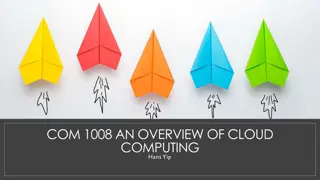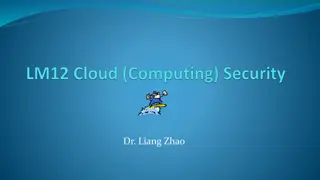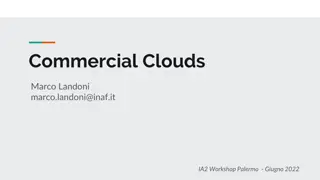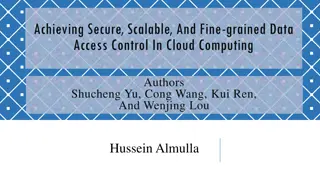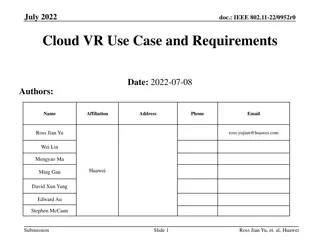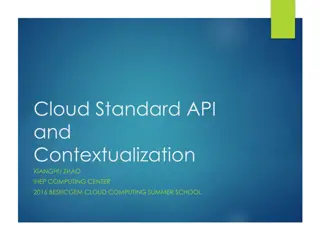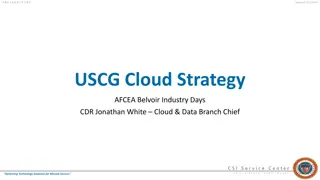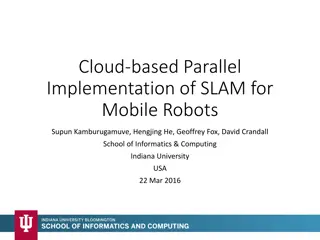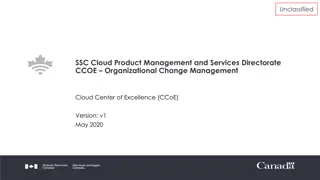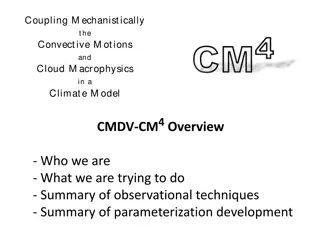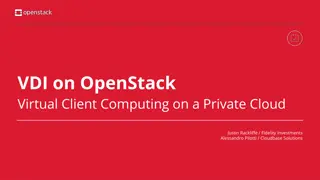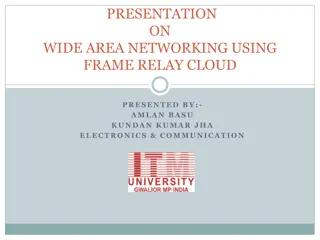Understanding the Value of Cloud Computing
Cloud computing presents new opportunities with its shared multitenant utility model, offering access to pooled resources on a pay-as-you-go basis. This paradigm shifts the economics of IT infrastructures, benefiting applications through economies of scale, asset commoditization, and adherence to programming standards. The cloud's unique characteristics include scalability, elasticity, low entry barriers, and utility pricing. Companies enter the cloud market for profit, optimization, strategic positioning, extension of products, and customer relationship enhancement. Cloud providers offer presence in markets, rapid scaling abilities, and platform services for independent software vendors.
Download Presentation

Please find below an Image/Link to download the presentation.
The content on the website is provided AS IS for your information and personal use only. It may not be sold, licensed, or shared on other websites without obtaining consent from the author. Download presentation by click this link. If you encounter any issues during the download, it is possible that the publisher has removed the file from their server.
E N D
Presentation Transcript
MEASURING THE CLOUD'S VALUE
Measuring the Cloud's Value Cloud computing presents new opportunities to users and developers because it is based on the paradigm of a shared multitenant utility. The ability to access pooled resources on a pay-as-you-go basis provides a number of system characteristics that completely alter the economics of information technology infrastructures and allows new types of access and business models for user applications.
Any application or process that benefits from economies of scale, commoditization of assets, and conformance to programming standards benefits from the application of cloud computing
What is cloud? A cloud is defined as the combination of the infrastructure of a datacenter with the ability to provision hardware and software.
Unique characteristics of an ideal cloud computing model Scalability: You have access to unlimited computer resources as needed. This feature obviates the need for planning and provisioning. It also enables batch processing, which greatly speeds up high-processing applications. Elasticity: You have the ability to right-size resources as required. This feature allows you to optimize your system and capture all possible transactions. Low barrier to entry: You can gain access to systems for a small investment. This feature offers access to global resources to small ventures and provides the ability to experiment with little risk. Utility: A pay-as-you-go model matches resources to need on an ongoing basis. This eliminates waste and has the added benefit of shifting risk from the client
Why companies Companies become cloud computing providers? Profit: The economies of scale can make this a profitable business. Optimization: The infrastructure already exists and isn't fully utilized. This was certainly the case for Amazon Web Services. Strategic: A cloud computing platform extends the company's products and defends their franchise. This is the case for Microsoft's Windows Azure Platform. Extension: A branded cloud computing platform can extend customer relationships by offering additional service options.
Presence: Establish a presence in a market before a large competitor can emerge. Google App Engine allows a developer to scale an application immediately. For Google, its office applications can be rolled out quickly and to large audiences. Platform: A cloud computing provider can become a hub master at the center of many ISV's (Independent Software Vendor) offerings. The customer relationship management provider SalesForce.com has a development platform called Force.com that is a PaaS offering.
Who opted for cloud first 1. Messaging and team collaboration applications 2. Cross enterprise integration projects 3. Infrastructure consolidation, server, and desktop virtualization efforts 4.Social strategy companies 5. Web content delivery services 6. Data analytics and computation 7. Mobility applications for the enterprise 8. CRM applications 9. Experimental deployments, test bed labs, and development efforts 10. Backup and archival storage
The law of cloudonomics 1. Utility services cost less even though they cost more. Utilities charge a premium for their services, but customers save money by not paying for services that they aren't using. 2. On-demand trumps forecasting. The ability to provision and tear down resources (de-provision) captures revenue and lowers costs. 3. The peak of the sum is never greater than the sum of the peaks. A cloud can deploy less capacity because the peaks of individual tenants in a shared system are averaged over time by the group of tenants. .
The law of cloudonomics 4. Aggregate demand is smoother than individual. Multi-tenancy also tends to average the variability intrinsic in individual demand. With a more predictable demand and less variation, clouds can run at higher utilization rates than captive systems. This allows cloud systems to operate at higher efficiencies and lower costs. 5. Average unit costs are reduced by distributing fixed costs over more units of output. Cloud vendors have a size that allows them to purchase resources at significantly reduced prices. 6. Superiority in numbers is the most important factor in the result of a combat (Clausewitz). Weinman argues that a large cloud's size has the ability to repel botnets and DDoS attacks better than smaller systems do.
The law of cloudonomics 7. Space-time is a continuum (Einstein/Minkowski). The ability of a task to be accomplished in the cloud using parallel processing allows real-time business to respond quicker to business conditions and accelerates decision making providing a measurable advantage. 8. Dispersion is the inverse square of latency. Cutting latency in half requires four times the number of nodes in a system. 9. Don't put all your eggs in one basket. Large cloud providers with geographically dispersed sites worldwide therefore achieve reliability rates that are hard for private systems to achieve.
The law of cloudonomics 10. An object at rest tends to stay at rest (Newton). Private datacenters tend to be located in places where the company or unit was founded or acquired. Cloud providers can site their datacenters in what are called greenfield sites. A greenfield site is one that is environmentally friendly: locations that are on a network backbone, have cheap access to power and cooling, where land is inexpensive, and the environmental impact is low.
Laws of Behavioral Cloudonomics 1. People are risk averse and loss averse. 2. People have a flat-rate bias. 3. People have the need to control their environment and remain anonymous. 4. People fear change. 5. People value what they own more than what they are given. 6. People favor the status quo and invest accordingly.
7. People discount future risk and favor instant gratification. 8. People favor things that are free. 9. People have the need for status. 10. People are incapacitated by choice.
Measuring cloud computing costs The cost of a cloud computing deployment is roughly estimated to be CostCLOUD= (UnitCostCLOUDx (Revenue CostCLOUD)) where the unit cost is usually defined as the cost of a machine instance per hour or another resource.
To compare your cost benefit with a private cloud, you will want to compare the value you determine in the previous equation with the same calculation: CostDATACENTER= (UnitCostDATACENTERx (Revenue (CostDATACENTER/Utilization))
The CostDATACENTER consists of the summation of the cost of each of the individual systems with all the associated resources, as follows: CostDATACENTER = 1n (UnitCostDATACENTER x (Revenue (CostDATACENTER/Utilization))SYSTEMn, where the sum includes terms for System 1, System 2, System 3, and so on.
The costs associated with the cloud model are calculated rather differently. Each resource has its own specific cost and many resources can be provisioned independently of one another. In theory, therefore, the CostCLOUD is better represented by the equation: CostCLOUD = 1n (UnitCostCLOUD x (Revenue CostCLOUD))INSTANCEn + 1n (UnitCostCLOUD x (Revenue CostCLOUD))STORAGE_UNITn +. 1n (UnitCostCLOUD x (Revenue CostCLOUD))NETWORK_UNITn +
Defining Licensing Models When you purchase shrink-wrapped software, you are using that software based on a licensing agreement called a EULA or End User License Agreement. The EULA may specify that the software meets the following criteria: It is yours to own. It can be installed on a single or multiple machines. It allows for one or more connections. It has whatever limit the ISV(independent software vendor) has placed on its software. In most instances, the purchase price of the software is directly tied to the EULA.
Chapter 3: Understanding Cloud Architecture IN THIS CHAPTER Using the cloud computing stack to describe different models Understanding how platforms and virtual appliances are used Learning how cloud communications work Discovering the new world of the cloud client
One property that differentiates cloud computing is referred to as composability, which is the ability to build applications from component parts. A platform is a cloud computing service that is both hardware and software. Platforms are used to create more complex software. Virtual appliances are an important example of a platform, and they are becoming a very important standard cloud computing deployment object.
Cloud computing requires some standard protocols with which different layers of hardware, software and clients can communicate with one another. Many of these protocols are standard Internet protocols. Cloud computing relies on a set of protocols needed to manage interprocess communications that have been developed over the years. The most commonly used set of protocols uses XML as the messaging format, the Simple Object Access Protocol (SOAP) protocol as the object model, and a set of discovery and description protocols based Description Language (WSDL) to manage transactions. on the Web Services
Some completely new clients are under development that are specifically meant to connect to the cloud. These clients have as their focus cloud applications and services, and are often hardened and more securely connected. Two examples presented are Jolicloud and Google Chrome OS. They represent a new client model that is likely to have considerable impact.
Exploring the Cloud Computing Stack Composability Infrastructure Platforms Virtual Appliances Communication Protocols Applications
Composability A composable component must be: Modular: It is a self-contained and independent unit that is cooperative, reusable, and replaceable. Stateless: A transaction is executed without regard to other transactions or requests.
The essence of a service oriented design is that services are constructed from a set of modules using standard communications interfaces. An example of a set of widely used standards describes the services themselves in terms of the Web Services Description Language (WSDL), data exchange between services using some form of XML, and the communications between the services using the SOAP protocol. There and service
Infrastructure Most large Infrastructure as a Service (IaaS) providers rely on virtual machine technology to deliver servers that can run applications. Virtual servers described in terms of a machine image or instance have characteristics that often can be described in terms of real servers delivering a certain number of microprocessor (CPU) cycles, memory access, and network bandwidth to customers. Virtual machines are containers that are assigned specific resources. The software that runs in the virtual machines is what defines the utility of the cloud computing system.
Arch dig illustrates the Portion of cloud computing stack that is designated as the server
Platforms Platform in the cloud is a software layer that is used to create higher levels of service. Salesforce.com's Force.com Platform Windows Azure Platform Google Apps and the Google AppEngine
A virtual appliance is software that installs as middleware onto a virtual machine.
Virtual Appliances Virtual appliances are software installed on virtual servers application modules that are meant to run a particular machine instance or image type. A virtual appliance is a platform instance. Therefore, virtual appliances occupy the middle of the cloud computing stack
What is a Web Service A method of communication between two electronic devices over the Web A software system designed to support interoperable machine-to-machine interaction over a network
In Cloud, REST vs SOAP SOAP is all about servers talking to servers, with rigid standards, extensive design, serious programming, and heavyweight infrastructure all essential parts of the equation. If you re building a mission-critical distributed application that will spend its life behind your corporate firewall, SOAP is a great choice. On the other hand, if you re interested in building your applications quickly and with maximum portability especially if the Cloud (public, private, or hybrid) is in the picture it s hard to beat REST. It supports a mere handful of simple HTTP API commands, and every object (known as a resource ) has its own unique Uniform Resource Identifier (URI) that provides a path and distinct name.
Contd.. Web service An interface described in a machine-processable format (WSDL, or Web Services Description Language) Other systems interact with the Web service using SOAP messages, typically conveyed using XML/HTTP and other Web-related standards SOAP: Simple Object Access Protocol Two major classes of Web services REST-compliant To manipulate XML representations of Web resources using a uniform set of stateless operations Arbitrary UDDI (Universal Description, Discovery and Integration (Directory Service).
Simple Object Access Protocol (SOAP) A protocol for exchanging structured information in the implementation of Web Services XML: for message format HTTP, SMTP: for message transmission
Web APIs Moving from SOAP based services to REST based communications REST: Representational State Transfer Do not require XML, SOAP, WSDL Typically a defined set of HTTP request messages along with the structure of response messages expressed in XML or JSON format JSON: JavaScript Object Notation They allow the combination of multiple Web services into new applications known as mashups
Web Services in a Service-Oriented Architecture
Three Most Common Styles of Use RPC (Remote Procedure Calls) A distributed function call interface SOA (Service-Oriented Architecture) The basic unit of communication is a message, rather than an operation REST (Representational State Transfer) Standard operations in HTTP: GET, POST, PUT, DELETE Interacting with stateful resources, rather than messgaes or operations
RPC Web Services Basic unit: WSDL operation Widely deployed and supported, but not loosely coupled Other approaches: CORBA, RPC, Java RMI
SOA Web Services Basic unit: message Supported by most major vendors, loose coupling
Representational State Transfer (REST) Interacting with stateful resources, rather than messages or operations Using HTTP standard operations such as GET, POST, PUT, DELETE WSDL 2.0 offers support for binding to all HTTP request methods WSDL 1.1 only GET and POST
RESTful Web API Four aspects Base URI for the Web service Internet media type of the data supported by the Web service E.g. JSON, XML, or YAML The set of operations supported by the Web service using HTTP methods E.g. GET, PUT, POST, or DELETE The API must be hypertext driven
RESTful Web services: Basics Use HTTP methods explicitly Be stateless Expose directory structure-like URIs Transfer XML, JSON, or both
Be Stateless For scalability, clients are required to send complete, independent requests include all data needed to be fulfilled so that the components in the intermediary servers may forward, route, and load-balance without any state being held locally in between requests
Connecting to a Cloud A web Browser A proprietary application
Use a secure protocol to transfer data HTTP,FTPS,Ip sec Create a Virtual connection using VPN or use remote data transfer Protocol Encrypt the data so that even if data is intercepted or sniffed ,the data will not be meaningful.
